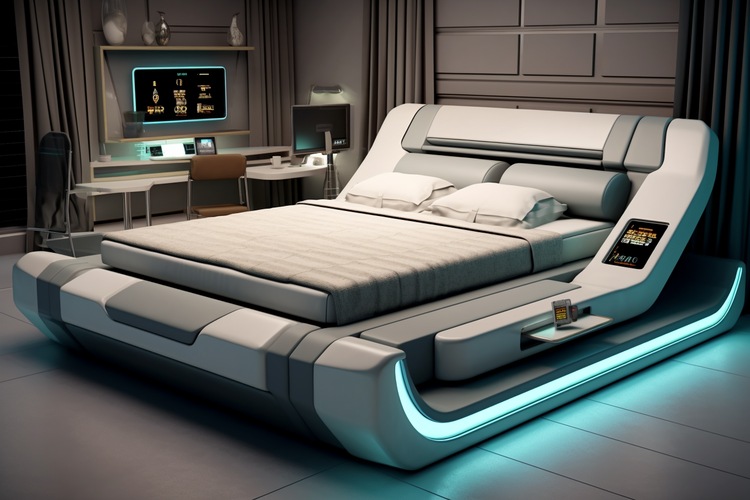Neon Nostalgia: The Resurgence of Retro-Futurism in Home Decor
Imagine stepping into a living room where vibrant neon signs cast a soft glow over sleek, chrome-lined furniture. The air hums with the gentle whir of a vintage record player, while holographic art pieces shimmer on the walls. This isn't a scene from a sci-fi movie—it's the latest trend in home decor: Retro-Futurism.

The Origins of Retro-Futurism
Retro-Futurism has its roots in the mid-20th century, particularly in the 1950s and 1960s. During this era, rapid technological advancements and the Space Race fueled public imagination about what the future might hold. Artists, designers, and filmmakers created visions of tomorrow that were often wildly optimistic and fantastical.
These futuristic predictions, while sometimes far from reality, left an indelible mark on popular culture. The sleek lines of flying cars, the efficiency of robot housekeepers, and the promise of space-age living captured the hearts and minds of generations. Today, as we navigate an increasingly digital world, there’s a growing nostalgia for these retro visions of the future.
Key Elements of Retro-Futuristic Design
Retro-Futurism in home decor is characterized by a unique blend of vintage and futuristic elements. Some key features include:
-
Bold Color Palettes: Vibrant neons, deep metallics, and stark contrasts are hallmarks of this style.
-
Geometric Shapes: Circles, triangles, and asymmetrical forms dominate furniture and decor pieces.
-
Space-Age Materials: Chrome, plastic, and glass are used extensively to create a futuristic feel.
-
Atomic and Celestial Motifs: Starburst patterns, atomic symbols, and planetary designs are common.
-
Retrofitted Technology: Modern tech is often housed in vintage-inspired casings.
Incorporating Retro-Futurism in Modern Homes
Embracing Retro-Futurism doesn’t mean turning your home into a sci-fi movie set. Instead, it’s about incorporating elements that nod to both the past and the future. Here are some ways to introduce this style into your space:
-
Statement Lighting: Opt for fixtures that resemble UFOs or atomic structures. Neon signs or LED strips can add a futuristic glow.
-
Furniture Selection: Look for pieces with curved lines and space-age shapes. Egg chairs, bubble lamps, and boomerang-shaped coffee tables are iconic choices.
-
Color Schemes: Use a base of neutrals accented with pops of bright colors like electric blue, acid green, or hot pink.
-
Wall Art: Incorporate retro-inspired posters, abstract geometric prints, or digital art displays that showcase futuristic scenes.
-
Smart Home Integration: Balance retro aesthetics with modern technology by disguising smart home devices in vintage-inspired casings.
The Psychology Behind the Trend
The resurgence of Retro-Futurism in home decor isn’t just about aesthetics—it’s deeply rooted in psychology. In uncertain times, people often look to the past for comfort while simultaneously seeking hope for the future. Retro-Futurism offers a unique solution by providing a sense of nostalgia coupled with optimism for what’s to come.
This design trend allows homeowners to create spaces that feel both familiar and exciting. It’s a way of honoring the imaginative spirit of the past while embracing the possibilities of the future. In a world where technology is advancing at a rapid pace, Retro-Futurism offers a playful and comforting approach to integrating these changes into our daily lives.
Sustainability in Retro-Futuristic Design
While the original Retro-Futuristic visions may not have prioritized environmental concerns, modern interpretations of this style are increasingly focusing on sustainability. Designers are finding innovative ways to incorporate eco-friendly materials and practices into Retro-Futuristic decor:
-
Upcycling Vintage Items: Repurposing old electronics or furniture pieces to fit the aesthetic.
-
Energy-Efficient Lighting: Using LED technology to recreate the neon glow without excessive energy consumption.
-
Sustainable Materials: Opting for recycled plastics and responsibly sourced metals in furniture and decor items.
-
Smart Home Integration: Incorporating energy-saving smart home systems that align with the futuristic theme.
Challenges and Considerations
While Retro-Futurism offers exciting design possibilities, it’s not without its challenges. Balancing vintage elements with modern functionality requires careful consideration. Here are some potential pitfalls to avoid:
-
Over-Theming: It’s easy to go overboard with Retro-Futuristic elements. The key is to create a cohesive look without turning your home into a theme park.
-
Functionality vs. Aesthetics: Ensure that your space remains practical and comfortable, not just visually striking.
-
Timelessness: While embracing a trend, consider how the design will age. Aim for a balance that won’t feel dated too quickly.
-
Budget Constraints: Authentic vintage pieces or custom-made Retro-Futuristic items can be expensive. Look for creative DIY alternatives or modern reproductions.
The Future of Retro-Futurism
As we move forward, the Retro-Futuristic trend is likely to evolve. We may see increased integration of augmented reality and holographic technology, allowing homeowners to change their decor at the touch of a button. The line between past and future will continue to blur, creating exciting new possibilities for home design.
Retro-Futurism in home decor is more than just a passing fad—it’s a reflection of our complex relationship with time, technology, and aesthetics. By embracing this style, homeowners can create spaces that are at once comforting and inspiring, rooted in nostalgia yet open to the possibilities of tomorrow. As we continue to navigate an ever-changing world, the allure of Retro-Futurism offers a unique way to honor our past while looking optimistically towards the future.





